Part 3 of 3
(Article courtesy: John Waterhouse)

This is the last of three installments about my bicycle adventure: eighteen weeks, 10,800 kilometers and three countries, Indonesia, East Timor, and Australia. I rode this route from August 2014 to December 2014. The three articles summarize my impressions of the geography and the social, cultural, and culinary experiences that I had.
Australia
My route in Australia went from Darwin which is on the tropical north coast directly south on the Stuart Highway to Port Augusta on the Southern Ocean, then east and south to Adelaide. From there I followed the coast along the Great Ocean Road to Melbourne, east to Canberra then directly east to Buli Beach and North to Sydney. This 5,000 KM stretch took from October 20th to December 20th.
I flew from Dili in East Timor to Darwin, the capital city of the Northern Territory of Australia, a flight of about one hour and a century. Darwin’s status in Australia is not unlike that of Yellowknife or Whitehorse in Canada. It is a frontier town and has a feel about it of being a bit raw at the edges. The aboriginal issues are much the same in the three towns: alcoholism, abusive language, and heart-breaking poverty amid prosperity and plenty. Such has been the case as I moved through the settlements on our way south.
The Outback
I was amazed at how quickly I entered the outback. I had anticipated a significant period of transition from tropical jungle around Darwin to a scrubland wilderness. Not so. Fewer than 50KM south of Darwin the wallabies and kangaroos roam freely. Where there is water, there may be a cattle station. Otherwise, it is flat scrub with less and less scrub as I moved further south. The contrast with Indonesia could not be starker. There, it was not normally possible to go more than a few KMs without passing through a village or being inundated with more hello misters than one could cope with. Here I frequently rode 100KM without seeing a town, a roadside store, or any other sign of human habitation.
The oppressive heat is the common element of Indonesia and here. By 10:30 AM, it can be 35C. In the afternoon, who knows? My group was scheduled to camp for the entire Australian part of the tour. Despite this being desert, the heat lingered into the night, so much so that one could only lay on top of their sleeping bag and sweat.
My first rest day in Australia was in Katheryn which is like small town Alberta, in the 50s. On Saturday, the shops all close at 2:00PM and will open again on Monday. Our campground/hotel restaurant is closed tonight. Small outback towns do not have a lot of amenities. In both Tennant Creek and in Katheryn the main restaurant in town is at the local casino, or what is locally called, the club. Obligingly, these establishments will send a van to the campground or hotel to pick people up and return them after dining and, presumably, gambling. People like me who do not gamble get a fairly good meal and some drinks at a reasonable price, by expensive Australian standards. There is a beauty to the outback. The soil and rocks really are red, and it is immense. Wildlife is scarce but kangaroos and wallabies appear periodically and there are a surprisingly large number of birds including white parrots, crows, and magpies. The outback can and does surprise. On October 29th we stayed at the small village of Daly Waters. About 3 KM out of town was the Mataranka springs, an amazing oasis with a clear warm water spring forming a small river and perfect swimming hole. The surrounding vegetation is tropical and the whole place is serene and peaceful
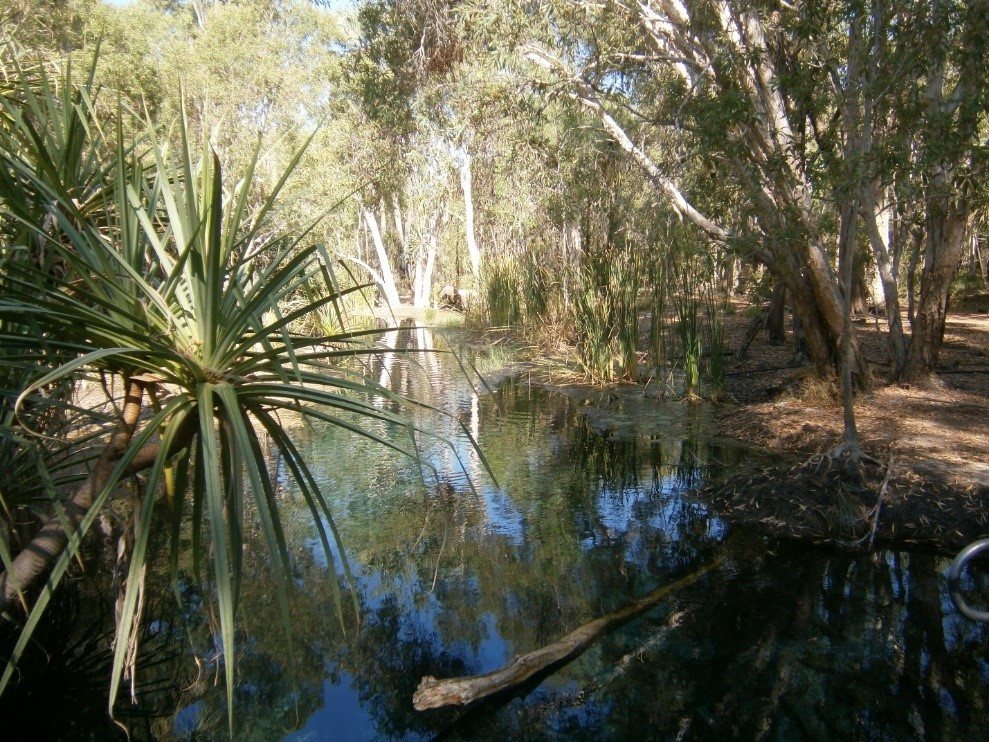
Road trains area feature of the Stuart highway which connects Darwin with Port Agusta. These large trucks have three or four trailers and seem to be the main means for transporting everything from minerals to cattle. The drivers are generally quite courteous, but they do create quite a wake.
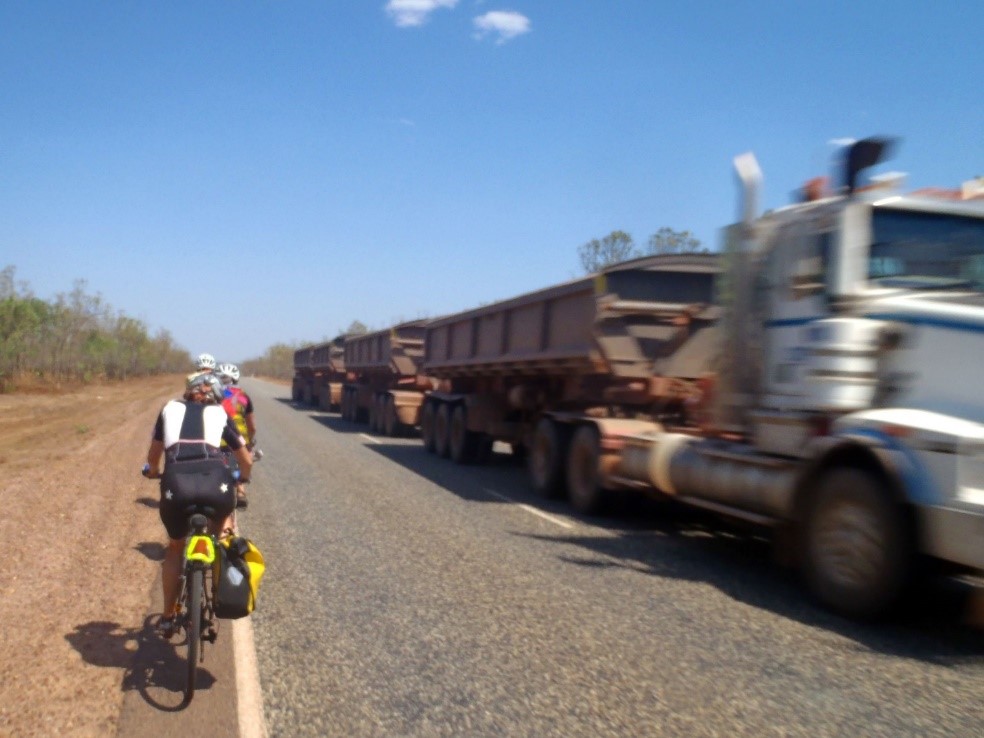
Another Road Train
A typical day starts at 4:30 AM with breaking camp and a breakfast of oatmeal and peanut butter sandwiches for those with big appetites. On the road by 6:00 or a bit earlier if light permits, and a sprint to get in as much distance as possible before it gets hot. By 10:00 AM, temperatures were in the low 30s reaching 40 or so by noon. Depending on the availability of camp sites, the day’s ride would be somewhere between 100 and 170 KMs with a lunch stop at about 2/3 of the way. Speed is largely dependent on the wind conditions. A head wind is exhausting and reduces speed by a lot. A strong tail wind which makes it easy to cover 160KMs before noon. Dinner is at 5:30 PM and, bed is early.
I would not have thought it possible to consume so much liquid in a single day. By 1:00 PM on a typical day, I would drink 2 x 750 ML bottles of water, a large bottle of Coke, a one and one quarter liter container of lemonade, a liter of ice water and a pint (or two) of beer. And I would still be thirsty. The rule of thumb, keep drinking until you must pee.
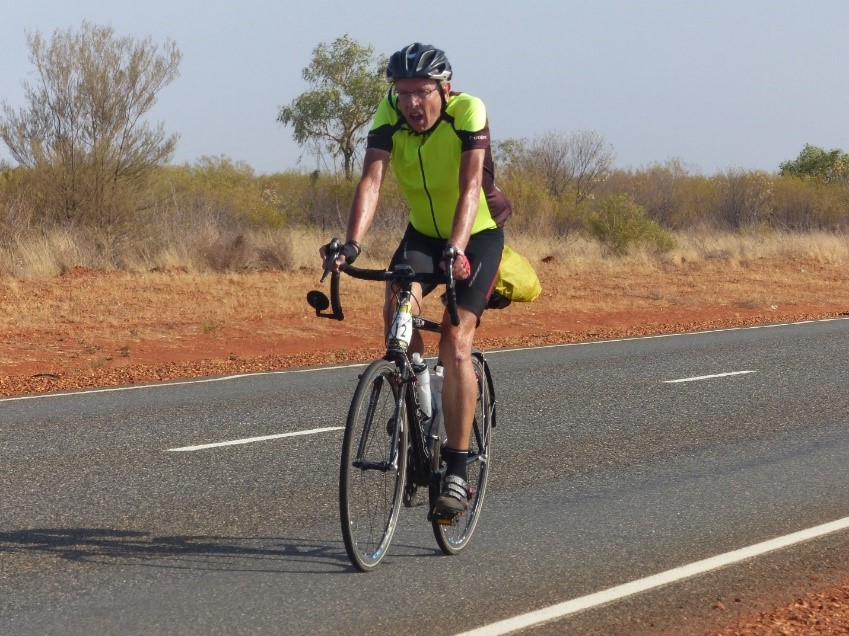
I had the pleasure of celebrating and watching the Melbourne Cup horse race on November 4th. This is called the race that stops a country and I believe it. Apparently in the cities, businesses close for the day of the race and most non-celebration activity stops. Here in the outback, the roadhouse adjacent to our campground was the center of local celebrations. Local folk (by which I mean all dozen or so people within a 100 KM radius) came to the bar. A complementary spread of food was put out (a big mistake with 20 or so hungry bicycle riders hanging around) and bets were placed. Like all horse races, the actual race was over quickly but that suited the Aussie love of celebration just fine, thank-you, as people were no longer distracted by the race.
Alice Springs is the Center of the outback. Actually, a billboard between two little towns to the North of Alice Springs, Barrow Creek and Allerton claims to be the center of the expanding outback, whatever ever expanding means. I would have thought that the outback has expanded quite enough.
This is an immense and largely empty country. From Darwin to Port Augusta is about 3,000 KM. There are few towns and only the occasional roadhouse. We “bush camp” some days because there simply are no facilities within our 150KM or so riding range. Several of us booked a tour of Uluru and Kings Canyon on two of our rest days in Alice Springs, naively thinking that the famous rock (that would be Ayer’s) is close to Alice Springs. Such is not the case as we rode the bus for a 1,500 KM round trip. During the trip we went through a cattle station that is the size of Denmark. (By the way it was for sale, for $6 million). As I say, a big country.
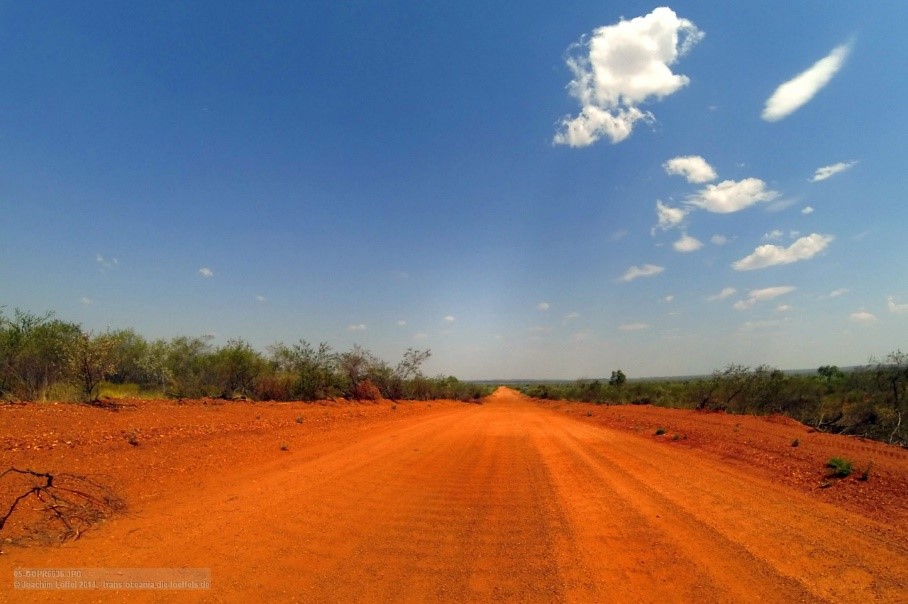
Coober Pedy is a small mining town famous as the world center for opal mining. It is a truly forbidding place. Opal is mined by digging holes with a digger of some sort and hopefully finding opal. (Apparently Coober Pedy is a name derived from the aboriginal word for “white fellas’ holes”.) Large mounds of dirt and open pits are left behind. The landscape looks like it has been ravished by giant gophers. But that is only one of the features that makes it so forbidding. It is unbearably, blisteringly hot. My Garmin read 45 C as I rode into town. It is so hot that many houses and hotels are built underground. The “campground” was to be in an old mine. A rebellion by the riders forced TDA to move us to a motel in town.
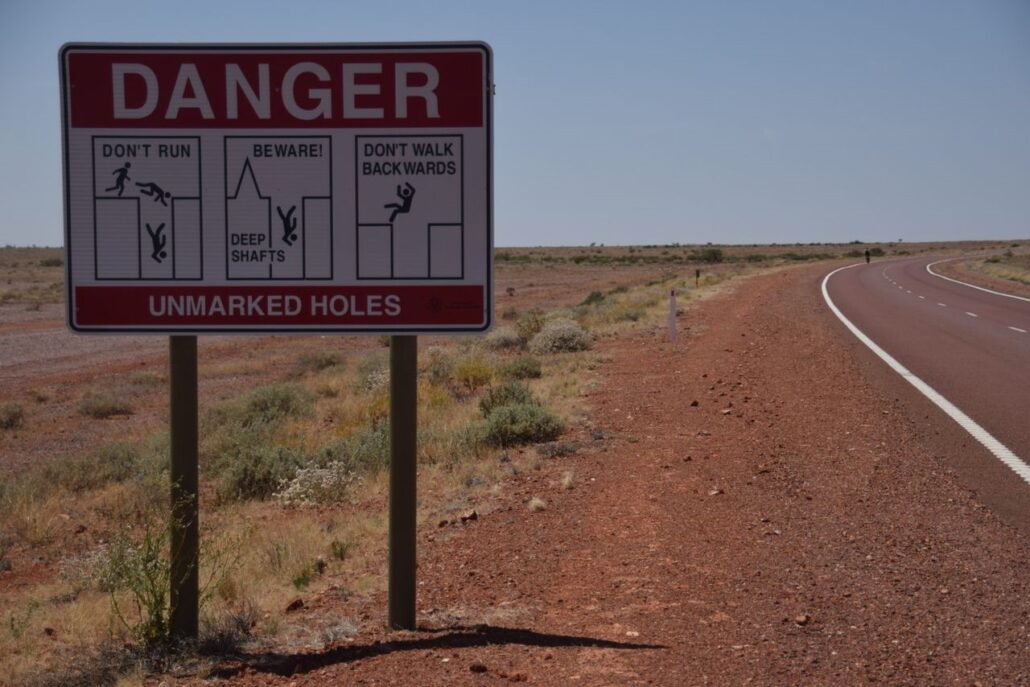
After riding for 3,000KM in about a month across the Australian outback, I can muster a few random observations. For what they are worth, here they are:
1. It is so big and empty that one grasps for words to describe it. Vast, immense, and endless do the job inadequately. Some examples of size: the Stuart highway on which we rode is the only north-south route between Darwin and Port Augusta. One feature of the highway is that fighter airplanes can practice landing and taking off on it. It was closed for a period for this purpose just after we passed through the area. In many spots one can see only horizon: no trees, no buildings, no animals, nothing but an endless vast not much.
2. It is hot and dry, most of the time. Just before Coober Pedy, I had temperature readings of 45 degrees. Until that point, temps were consistently in the high 30s during the afternoon. The wind at times was relentless. All in all, hot and dry would be an understatement. Then, south of Coober Pedy it rained. Not much rain but it was rain. The temperature one morning was 8. Then it is back up to 40 or so.
3. Despite the desolate appearance, there is life out there. Kangaroos and wallabies plus a lot of other desert creatures are nocturnal hence one does not normally see much of them during the day. (Smart that they are). However, every now and then one sees them by the road. On my way, a small mob of roos lopped along beside me for a while. Their communication was not good as the lead roo decided to stop without telling the second one who tripped over him. (Cyclists are familiar with this). Unfortunately, one sees also a lot of roadkill because roos do hop around at night. We have seen several flocks (?) of emus. And one must remember that the aboriginals lived here for centuries and managed to make a living at it.
4. The outback is one of the sources of Australia’s wealth. One does see road trains of cattle and sheep being hauled off to market. And one sees some evidence of the mining industry. Trucks transporting heavy equipment seem to appear out of nowhere. Every now and then a unit train of iron ore of coal appears. So, there is commercial activity. It is just that it is spread over a vast area.
5. It is beautiful. Like other desert areas such as in Arizona or the Sahara, there is a real beauty to it. The colors, mostly hues of red, are amazing. Sunsets and sunrises are beyond compare. Outcroppings of rock or what the locals call mountains are even more beautiful because of their scarcity and the contrast that they create. So, there is a sense of wonder that one gets from the place.
6. The roadhouses are interesting. According to the stories told in information centers, roadhouses were established when goods were hauled by camel, horse, or oxen from ports such as Port Augusta to the outback. Oxen could only travel six or seven miles per day, so they needed a place for the drivers to refresh and the animals to recover. Hence, sleeping and eating places along the trail. As transportation methods changed the roadhouses thinned out so that now there might be one every 150 KM or so. They service the “local “ranchers, passing motorists and whoever happens by. Each has a bar, a store and food service of some sort. Many have sleeping accommodation of a sort which I rented on more than one occasion. All are run by characters, for example the chap at Daly Waters who has currency from 180 different countries pinned up behind his bar, including a Zimbabwe one billion dollar note.
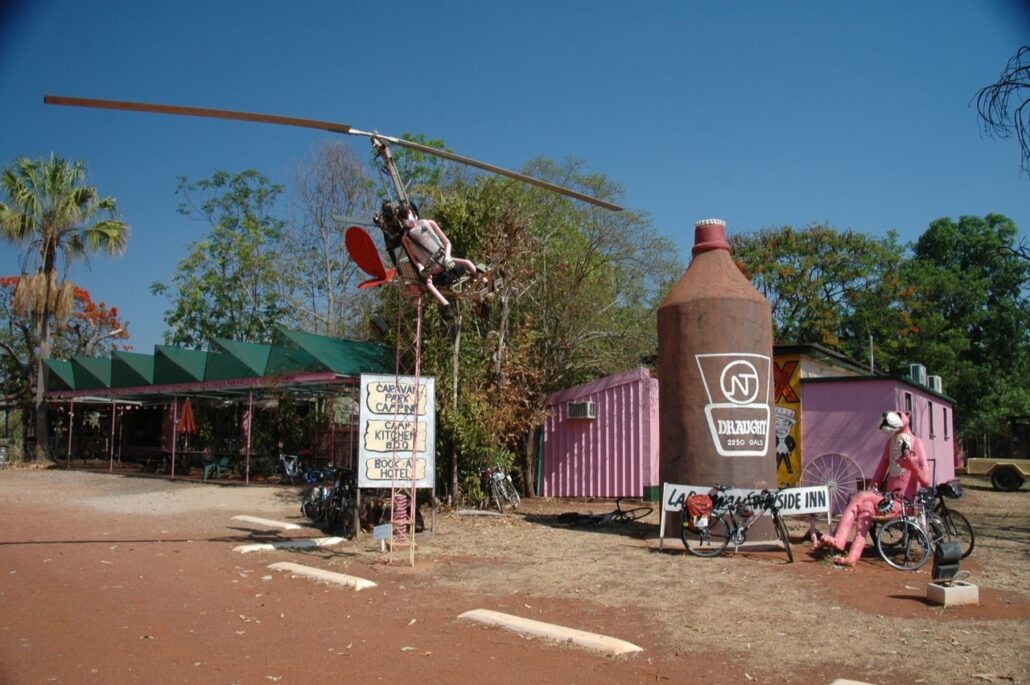
7. Roadkill: Cyclists cannot help but notice roadkill through at least two senses. We have seen just about every domestic and wild animal, bird, and reptile after they have met their fate. The most common roadkill are kangaroos and wallabies. These creatures are nocturnal and attracted by, or at least mesmerized by the headlights of passing cars and trucks. Almost every vehicle that travels the outback has a roo catcher which is a supplemental bumper system that extends above the bonnet so that the victim does as little damage as possible to the vehicle and driver. (Perhaps these contraptions could be marketed in Newfoundland as moose guards.) In any case cars and trucks do a lot of damage to the marsupial population of the outback. Of course, we have come across the usual assortment of other animals, birds, and reptiles at the side of the road. I do not believe that Australia has any large carnivores such bears, coyotes or wolves which leaves only scavenger birds to clean up the mess.
8. The riding: I liked my ride through the outback. It is too easy to focus on the negatives such as the long rides, bush camps, heat, and wind. However, it is an amazing part of the world, and I am glad that I did it.
After the Outback
So, those are some of my observations about the Australian outback. We left the Stuart Highway at Port Augusta. This is the port that served as the gateway to take materials into the outback and product out to market.
Another sudden transition: from Port Augusta it is a short ride across a flat desert plane to the Flinders Range and another short ride into another world. As if turning on the lights in a darkened room one emerges into farm country with vast wheat fields and real towns filled with people, shops, and other amenities that I had not experienced for three months. I soon passed into the Clare Valley and wine country to the north of Adelaide. Three more days to Adelaide and then on to the Great Ocean Road and Melbourne.
I had another transition leaving Adelaide, from the warmth and gentle embrace of the Clare and Barossa Vallys to the cool and windy oceanside. Which brings me to roadkill, again. I am cycling by the ocean. It is very windy. I am struggling to make headway. I look down. And there it is, a roadkill fish. I kid you not. Was the misshaped fish a victim of the winds, a bird who lost its grip, or a fisher’s good luck turned bad? Roadkill is roadkill, I hope we are not having fish for dinner the next few nights.
Most long-distance cyclists are obsessed with food. I had lost a bit of weight that I tried my best to gain back. Not having seen a scale in months, I did not know how much my weight decreased but I guessed by at least fifteen pounds (from one hundred and fifty). So, I resolved to eat more. A typical day was breakfast at 6:00 AM, which was pretty much always the same: oatmeal with honey and some fruit and a peanut butter sandwich. A coffee and snack stop by 8:00 AM or so, then between 10:00 and 11:00 a lunch stop consisting of two or three sandwiches and lots of fruit, then steaming pot of soup upon arrival in camp in early afternoon, and then it is off to find a restaurant for a second lunch. Fish and chips followed by chocolate milk shake takes the edge off until happy hour. This is wine country so a glass or two (or maybe three) of Shiraz and some nibblies brings me to the main meal of the day. Two heaping helpings of everything (we have a very good chef looking after us). Before bed, one or two Magnum ice cream bars rounded off the day.
I have no idea how many calories this is or if it is having the desired effect of adding weight. I do know that I am still pretty much always hungry. Returning to normal eating patterns might be a challenge when I re-enter the other world. (P.S. they didn’t, it took a couple of months for my appetite to settle down.)
The ride along the Great Ocean Road, is very spectacular. With cliffs falling away to the ocean on one side and beautiful rolling hills on the other it is deserving of its moniker. As hot and flat as was the outback, this part of the trip was cool and hilly. We passed through this part of Australia during the period approaching the summer solstice, what for us northern hemisphere types would be mid-June. Given the latitude, one would expect warmth, right? It was not to be. We left Melbourne in a steady rain and cool temperatures and did not see warm weather and sunny skies until close to Sydney. I wore a rain jacket every day until noon or so, as much for warmth as to keep dry. We were to have camped every day in Australia, but I bailed on camping on most nights because of the cold and damp conditions. Fortunately, many of the caravan parks where we stopped had rooms to rent and so for $40 or $50 per night so I could avoid the tent and sleeping bag.
East of Melbourne with its rolling hills, mixed farms reminded me of southern Ontario. I remarked on how friendly and generous Indonesians are. Australians are too. While in Obrist, a wee little town in southeastern Australia, and following my high calorie diet, a friend and I were having a pizza and milkshake after the day’s ride. Seated beside us were two women ambulance drivers having a coffee. We began to chat, and they asked if we had seen the local park, Malo, where the Snowy River flows into the Great Southern Ocean. No, we said. One of the women said, you must, wait here. Off she went to fetch her car and we spent the next two hours on a private tour of the park and ocean beaches. What a kind gesture by Karen, to two complete strangers.
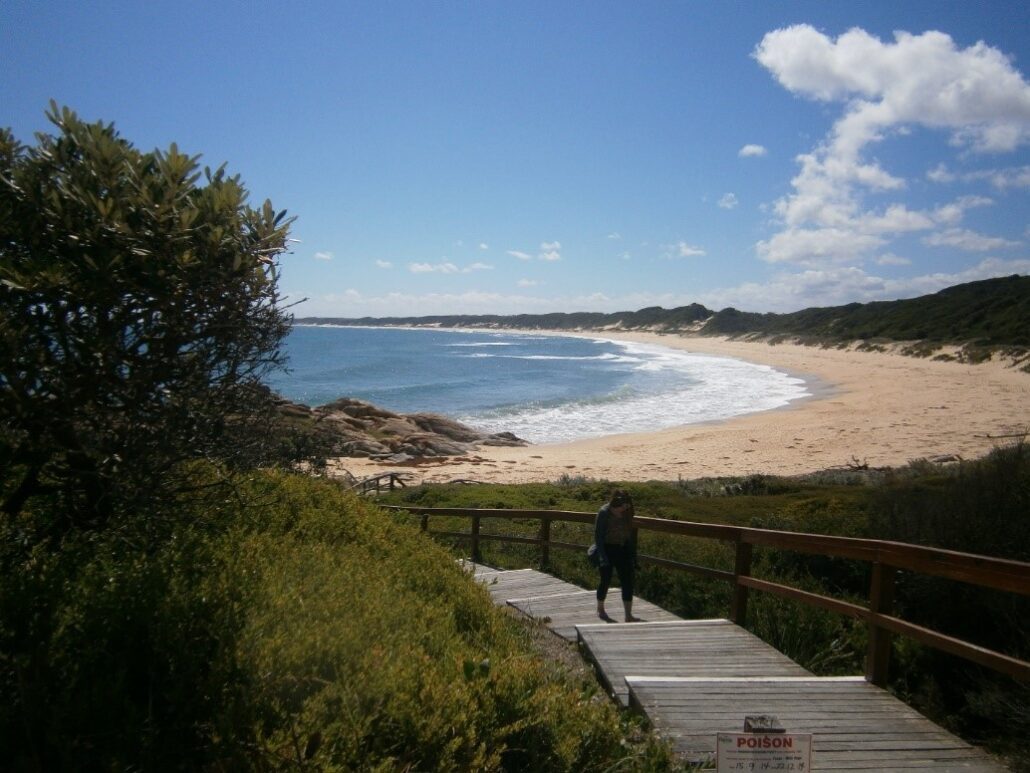
One of the most beautiful bike rides that I have ever experienced was from Bulli Beach which is 100 KM south of Sydney to Sydney. Vast beaches, then a beautiful park and wonderful vistas. Two ferry rides, the last by the fast ferry to Circular Key and a very short ride to our hotel in Sydney. Great stuff.
Some overall impressions and personal reflections of the ride:
This was a big physical challenge for me. Four and one-half months is a lot of time in the saddle. The sheer number days wear on one after a while. 10,500 KM or so is a long way. Total vertical was 90 KM. That is 90KM straight up. And I was pushed to do things that I would not normally do such as push my bike up a road that was too steep to ride or stay in a flea bag of a room. But it was all good. Our group travelled where no other group has travelled by bicycle. I felt fit having completed the trip and lost fifteen pounds. When asked by someone who I was chatting with in a restaurant along the way why I was doing this, my reply was “because I can”.
I met some remarkably friendly and helpful people along the way. The riders and staff were a pleasure to be with. Two examples from dozens of other people experiences:
When riding into a town on Java, I became hopelessly lost. I stopped to ask directions from a young man on a motor bike. He said “you are lost and a long way from your hotel. Let me show you the way”. He spent the next hour or so leading me through tangled streets, up and down hills and finally to the right hotel. He refused any form of compensation except a picture with me. Very kind.
Also in Java, going in a large city, I realized too late that I needed to make a left-hand turn but there were many lanes of traffic between me and that turn. I was stopped at a red light beside a vender peddling a three-wheel tricycle. I looked at him and he looked at me with a toothless grin. I indicated where I wanted to go and he gestured back, saying follow me. Off we went across an incredibly busy intersection. I am sure that he went considerably out of his way to help a stranded fellow cyclist.
The many scenic wonders are too numerous to list. A few that stand out: active volcanos (one of which blew up three weeks after we were there), manicured tea plantations and sculpted rice paddies, the incomparable outback, vast unoccupied beaches, strange animals, and birds and so many other things.
I also have a sense of personal accomplishment in doing what I did. I take special pride in having been being a sixty-nine-year-old senior who accomplished an amazing physical and mental challenge. So, there you have it.
P.S. If you enjoyed reading this series, let me know. I will soon have a self-published book that covers seven major bike trips that I have done. The title of the book is “A Cyclist’s Ten Life Lessons”, one of which is don’t go into a cowboy bar dressed in Spandex. I will be pleased to provide you with a complimentary copy of the book.
– John Waterhouse
